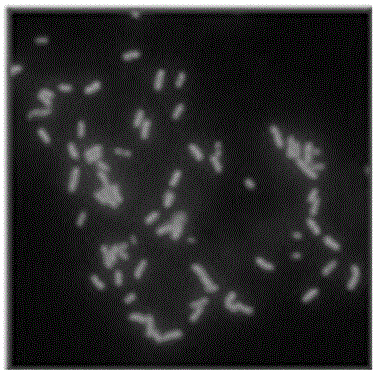Fluorescence in situ hybridization detection kit for detection of Mycobacterium tuberculosis infection
A fluorescent in situ hybridization and detection kit technology, which is applied in the field of medical detection, can solve the problems of poor specificity, false negatives, insufficient diagnostic techniques, etc., and achieve the effect of detection sensitivity
- Summary
- Abstract
- Description
- Claims
- Application Information
AI Technical Summary
Problems solved by technology
Method used
Image
Examples
Embodiment 1
[0028] The preparation of embodiment 1 specificity probe
[0029] According to the human tuberculosis gene sequence reported by NCBI, homology comparison analysis was carried out to find the most conserved region of the gene, and IS6110, MPRT40 and 16s rRNA genes were selected as target sequences, and primer5.0, oligo6.0 and Primer Express2.0 software, designed three groups of fluorescent probes specific to Bacillus. The probe was put into NCBI for BLAST homology analysis, and the result showed that it was heterologous to other gene sequences, thereby avoiding the existence of non-specificity during hybridization. The probe was synthesized by Sangon Bioengineering (Shanghai) Co., Ltd.
[0030] The sequences of the three oligonucleotide probes are respectively shown in SEQ ID NO: 1-3.
[0031] Preparation of fluorescently labeled probes: FITC fluorescein was selected, and the probes were directly labeled by the gap translation method. Directly attaching fluorescein to the pr...
Embodiment 2
[0041] The preparation of embodiment 2 detection kits
[0042] Hybridization solution composition: 10% (w / v) dextran sulfate, 10mM NaCl, 20% (v / v) formamide, 0.1% (w / v) sodium pyrophosphate, 0.2% (w / v) polyvinyl Pyrrolidone, 5mM Na2EDTA, 0.1% (v / v) TritonX-100, 50mM Tris / HCl (pH7.5); 30pM fluorescently labeled three specific probes (prepared in Example 1).
[0043] Preparation of DAPI counterstain: Take 2.2 mg of DAPI powder, add 550 μl of distilled water and mix well to make a DAPI stock solution of 4 mg / ml. Store at 4°C. Working solution: Take 2.5μl DAPI stock solution and add it to 5ml distilled water, mix well, 2μg / ml.
Embodiment 3
[0044] The application of embodiment 3 detection kits
[0045] Sputum samples and lesion tissue samples were taken from the same patient, a total of 20 cases.
[0046]The sputum samples were cultured by the Roche culture method, specifically, the modified Lowenstein-Jensen medium was selected to culture the treated sputum. Specifically, add 2 mL of 4% sodium hydroxide to 1 mL of sputum sample, vortex and oscillate for 30 seconds to mix, and let stand at room temperature for 20 minutes, during which time oscillate 2 to 3 times to promote liquefaction of sputum. Take 0.1mL of digested sputum with a sterile graduated capillary pipette, inoculate slowly and evenly on the slant of each culture medium, and culture in a 37°C incubator. Observe the culture situation on the 3rd and 7th day after inoculation, and then observe once a week until the end of the 8th day. If there is a positive culture, report it at any time. If no bacterial growth is found after 8 weeks of culture, the re...
PUM
 Login to View More
Login to View More Abstract
Description
Claims
Application Information
 Login to View More
Login to View More - R&D
- Intellectual Property
- Life Sciences
- Materials
- Tech Scout
- Unparalleled Data Quality
- Higher Quality Content
- 60% Fewer Hallucinations
Browse by: Latest US Patents, China's latest patents, Technical Efficacy Thesaurus, Application Domain, Technology Topic, Popular Technical Reports.
© 2025 PatSnap. All rights reserved.Legal|Privacy policy|Modern Slavery Act Transparency Statement|Sitemap|About US| Contact US: help@patsnap.com


